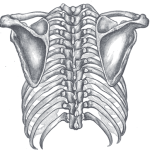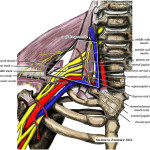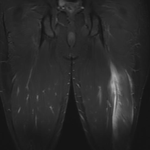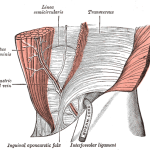Introduction
The last few articles on the site have focussed on assessment and treatment of shoulder dysfunctions. I make no excuse for this, as shoulder conditions are the second most common complaint I see in my clinical practice. Of these conditions, injuries to the rotator cuff are very common. Whilst rotator cuff injuries are more commonly seen in supraspinatus and infraspinatus, there has been a recent increase in awareness and recognition of subscapularis injuries. In fact, Barth et al. (2006) suggested 29.4% of those who underwent shoulder arthroscopy for rotator cuff tear had involvement of the subscapularis. Therefore, a thorough understanding of the evidence based clinical assessment for subscapularis is essential, and is presented below.
Subjective Examination
Patients or athletes who have sustained a subscapularis injury will report the following information during the subjective examination:
- Pain Area: the patient may complain of pain in both the posterior and anterosuperior shoulder, posterior arm, and even down to the wrist (see image below), and as such quite similar to the more common supraspinatus rotator cuff injuries.
- Mechanism: commonly reported mechanisms include during shoulder dislocation, forceful hyperextension, and external rotation of the adducted arm (Gerber and Krushell, 1991).
- Other Complaints: These patients will also complain of shoulder weakness which manifests as issues with arm elevation and overhead activity.
Objective Examination
The objective or physical examination of those with subscapularis injuries will likely uncover the following information:
- AROM: generally patients present with limited forward flexion, painful arcs of motion, and at times supraspinatus weakness (differentiation can be challengin) (Warner et al., 1994).
- PROM: in severe cases there will be an increase in passive external rotation (think loss of IR restraints) (Gerber and Krushell, 1991).
- RIMT: weakness during internal rotation testing will be evident (Warner et al., 1994)
- Palpation: there will be marked tenderness on palpation of the subscapularis tendon and muscle belly.
- Impingement tests will likely be positive.
Special Clinical Tests
The following are 3 clinical tests that have been identified as being useful in the diagnosis of subscapularis injuries (Barth et al., 2006; Greis et al., 1996, Pennock et al., 2011). These tests have been shown to isolate high levels of subscapularis muscle activity, whilst minimising the activity in other shoulder muscles and internal rotators (Pennock et al., 2011). Barth et al. (2006) provided results for the diagnostic accuracy of the 3 tests, and these are discussed below. Recently, Pennock et al. (2011) evaluated the effect of varying arm position on EMG activity of a number of shoulder muscles. Fortunately, the efficacy of the following clinical tests was not affected by arm position.
Bear Hug Test
- Sensitivity: 60%
- Specificity: 92%
- +ve LR: 7.5
- -ve LR: 0.43
Belly Press Test
- Sensitivity: 40%
- Specificity: 98%
- +ve LR: 20
- -ve LR: 0.61
Lift Off Test
- Sensitivity: 18%
- Specificity: 100%
- +ve LR: ∞
- -ve LR: 0.82
- The lift off test is not generally positive unless there is a greater than 75% tendon tear (Barth et al., 2006)
Take Home Messages
- Subjective reports for subscapularis injury are similar to that of supraspinatus and infraspinatus injuries.
- Clinical signs that help differential diagnosis includes internal rotation weakness and increased passive external rotation.
- 3 clinical tests that are helpful are: Bear Hug, Belly Press, and Lift Off Tests.
- Positive results are more clinically helpful than negative; secondary to the high specificities and low sensitivities of clinical tests.
What are your thoughts? Be sure to let me know in the comments or catch me on Facebook or Twitter
If you would like some more options for treating muscular imbalances in the upper body check this out.
Photo Credit: @giovanni
References
Barth JR, Burkhart SS, DeBeer JF. The bear-hug test: a new and sensitive test for diagnosing a subscapularis tear. Arthroscopy. 2006;22(10):1076-1084.
Gerber C, Hersche O, Farron A. Isolated rupture of the subscapularis tendon: results of operative repair. J Bone Joint Surg Am. 1996;78:1015-1023.
Gerber C, Krushell R. Isolated rupture of the tendon of the subscapularis muscle: clinical features in 16 cases. J Bone Joint Surg Br. 1991;73:389-394
Greis PE, Kuhn JE, Schultheis J, Hintermeister R, Hawkins R. Validation of the lift-off test and analysis of subscapularis activity during maximal internal rotation. Am J Sports Med. 1996;24(5):589-593.
Pennock AT, Pennington WW, Torry MR, Decker MJ, Vaishnav SB, Provencher MT, Millett PJ, Hackett TR. The influence of arm and shoulder position on the bear-hug, belly-press, and lift-off tests : An electromyographic study. Am J Sports Med 2011;39(11):2338
Warner JJP, Allen AA, Gerber C. Diagnosis and management of subscapularis tendon tears. Techniques in Orthopaedics. 1994;9(2):116-125.
Related Posts









